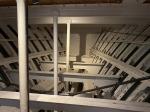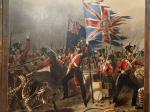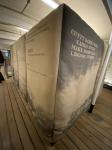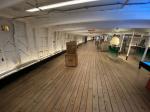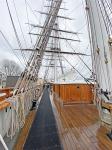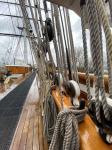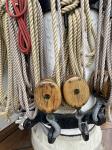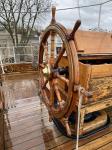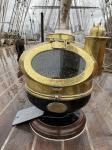The Cutty Sark
Greenwich Peninsula on the South bank of the River Thames is the home of the last surviving tea clipper the Cutty Sark. Built in 1869 in Dumbarton for the China tea trade, although during its working life the clipper has carried a range of goods, including wool, wine and spirits.
The boat has been carefully conserved over a six-year period of conservation with the original wooden planks and iron structures clearly visible below deck. A fascinating and interesting insight into what life was like on board is given through audio visual presentations on the lower deck. On the main deck the ship looks really impressive, its masts towering up into the sky above, apparently there is the equivalent of eleven miles of rigging, in its day it must have made an impressive sight with its sails up and full speed on the high seas.
The story boards on the lower deck made for some interesting reading, its maiden voyage was on the 15th February 1870 bound for Shanghai, the boat was loaded with General cargo. It reached China on the 31st May, where it was loaded with some 1,305,812 lbs of tea. After some twenty-five days in the port of Shanghai it sailed back to London, arriving on the 13th October 1870. The Cutty Sark completed eight trips to China for tea, collecting her last year cargo in 1877.
With the arrival of steam ships and the opening of the Suez Canal, the Cutty Sark had to find other goods to transport and from 1883 to 1895 the boat carried wool from Australia to London after which the steamships began to dominate the wool trade and it ceased to be profitable for a sailing ship. In 1895 the Cutty Sark was sold to a Portuguese firm. The ship traded various cargoes between Portugal, Rio de Janeiro, New Orleans, Mozambique, Angola, and Britain.
She continued as a cargo ship until purchased in 1922 by retired sea captain Wilfred Dowman, who used her as a training ship operating from Falmouth, Cornwall. After his death, Cutty Sark was transferred to the Thames Nautical Training College, Greenhithe in 1938 where she became an auxiliary cadet training ship alongside HMS Worcester.
In 1953 Cutty Sark was given to the Cutty Sark Preservation Society and in 1954 she was moved to a custom-built dry dock here at Greenwich. She was stripped of upper masts, yards, deckhouses and ballast to lighten her before being towed from the East India Import Dock to the special dry dock at Greenwich. The foundation stone of the dry dock was laid by The Duke of Edinburgh, patron of the Cutty Sark Preservation Society, in June 1953. Today the Cutty Sark has been preserved as a museum ship, and is a popular tourist attraction, even on a wet and windy day.
After our look around the ship we enjoyed a coffee and sandwich in the café under the hull of the boat before heading over to have a walk around Greenwich Market, and that’s another story.
|


